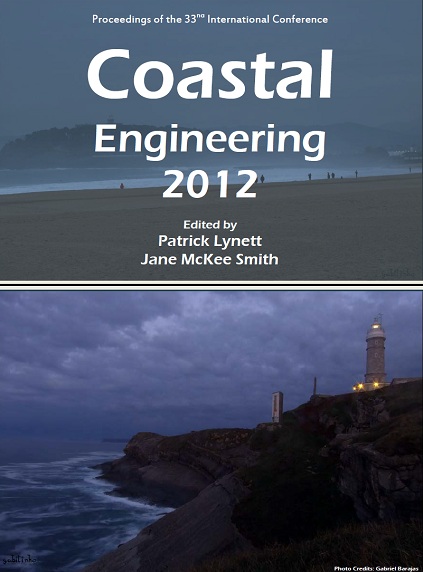Abstract
Based on the results of field surveys, coastal dike failures caused by the Great East Japan Earthquake were classified into eight patterns. The results of hydraulic model experiments related to major failure patterns reinforced the proposed failure processes. In addition, the aggregated length of each failure pattern showed that failure from scouring at the landward toe is the dominant failure pattern.References
Kato, F., S. Inagaki, and M. Fukuhama. 2007. Wave force on coastal dike due to tsunami, Proceedings of the 30th International Conference on Coastal Engineering, ASCE, 5150-5161.
Kato, F., K. Noguchi, Y. Suwa, T. Sakagami, and Y. Sato. 2012. Field survey on tsunami-induced topographical change, Journal of Japan Society of Civil Engineers, Ser. B3 (Ocean Engineering), Vol. 68, No. 2 (in press).
Mikami, T., T. Shibayama, M. Esteban, and R. Matsumaru. 2012. Field survey of the 2011 Tohoku Earthquake and Tsunami in Miyagi and Fukushima Prefectures, Coastal Engineering Journal, 54(1), 1250011.http://dx.doi.org/10.1142/S0578563412500118
Nishimura H., and K. Horikawa. 1979. Scouring at the toe of a seawall due to tsunami drawdown, Proceedings of the 26th Coastal Engineering Conference, JSCE, 210-214 (in Japanese)
Noguchi, K., S. Sato, and S. Tanaka. 1997. Large-scale experiments on tsunami overtopping and bed scour around coastal revetment, Proceedings of Coastal Engineering, JSCE, 44, 296-300 (in Japanese).http://dx.doi.org/10.2208/proce1989.44.296
Ogasawara, T., Y. Matsubayashi, S. Sakai, and T. Yasuda. 2012. Characteristics of the 2011 Tohoku Earthquake and Tsunami and its impact on the northern Iwate Coast, Coastal Engineering Journal, 54(1), 1250003.http://dx.doi.org/10.1142/S0578563412500039
River Research Department, National Institute for Land and Infrastructure Management. 2012. Preliminary report on resilient structures of coastal dike,
Shuto, N. 2009. Damages to coastal structures by tsunami-induced currents in the past, Journal of Disaster Research, 4(6), 462-468.

